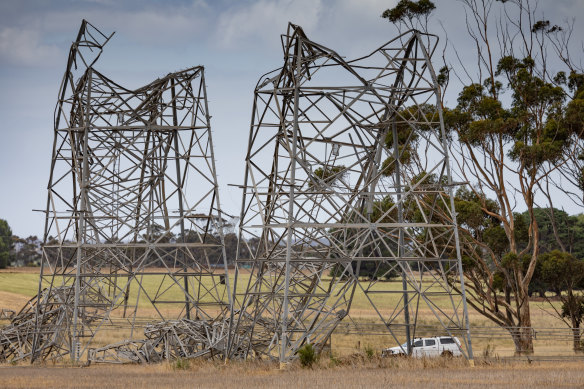
Electricity retailers have previously conducted trials to take advantage of market movements, with vehicles discharging their batteries when power prices are high and charging when prices are low.

Power lines came down in the You Yangs, near Geelong in Victoria, following windy and stormy weather in February.Credit: Jason South
“It’s a world first, in the sense that there’s not ever been a vehicle trial to respond so quickly to an emergency,” Sturmberg said.
EVs could play a huge role in the future electricity grid.
For NSW and the ACT, the Australian Energy Market Operator has contracted about 700 megawatts of emergency reserves, which is equivalent to the combined power supply in 105,000 EVs, Sturmberg said.
Emergency reserves are contracted by the electricity market operator from operators of generators such as big batteries and gas plants, so instantaneous power can be jolted into the grid in case of a power line collapse or other emergency.
“To put that in perspective,” Sturmberg said, “105,000 vehicles responding in this way would fully cover the back-up required for the whole of ACT and NSW”.
He said vehicle-to-grid technology would not only provide the grid with an extra power supply, it could also be used to cut demand when power supplies were running low.
The February power line collapse in Victoria not only cut supply to hundreds of thousands of homes, it sent a shock into the grid that effectively tripped a fuse connecting the grid to the massive Loy Yang A brown coal plant 240 kilometres to the east of Melbourne.
The loss of this coal plant prompted the energy market operator to trigger what’s known as load shedding – intentionally cutting power supply to about 90,000 homes to preserve stability in the grid.
Loading
“Stopping just 6000 vehicles charging would have kept the power on for those 90,000 customers whose power was cut on February 13,” Sturmberg said.
Carmakers could be required to fit their vehicles with technology that can respond to demand for power supply.
“It may call for an industry adjustment, for instance, to require EV manufacturers to program their vehicles to stop charging during a grid emergency, with an option for drivers to override for urgent charging,” Sturmberg said.
The federal government has not set a target for electric vehicle sales, but NSW, Victoria and Queensland have set targets for EVs to reach 50 per cent of new car sales by 2030 and 100 per cent by 2035.
The number of EVs has risen rapidly to exceed 8 per cent of new cars sold in 2023, up from just 3 per cent in 2022. On the current trajectory, EVs would reach 50 per cent of new car sales by 2033.
Cut through the noise of federal politics with news, views and expert analysis. Subscribers can sign up to our weekly Inside Politics newsletter.



























